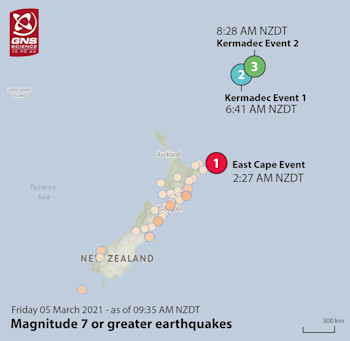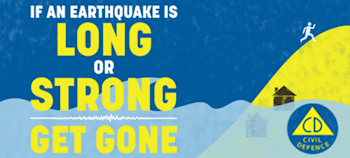
A morning of large offshore earthquakes - what happened and future scenarios
Updated: Fri Mar 12 2021 12:19 PM
Three large earthquakes have struck offshore New Zealand this morning all triggering tsunami alerts. Our scientists have developed three scenarios for what earthquakes may happen over the next 30 days.
What's Happened:
Early Friday morning, 5 March 2021, three large earthquakes occurred offshore New Zealand beginning with a M7.3 East Cape earthquake felt widely across the country. This was then followed a few hours later by a M7.4 and M8.1 earthquake in the Kermadecs.
We received over 52,000 felt reports for the M7.3 earthquake easily breaking our last record holder, a M5.8 earthquake offshore Levin in 2020, which had 36,867.
Tsunami:
NEMA (National Emergency Management Agency) issued tsunami alerts to the public following these events and so far, we have recorded tsunami arrivals from the East Cape earthquake as ~35-40cm at East Cape, and ~15-20cm at Great Barrier Island.
For an update on tsunami see here.
Future Scenarios:
We recognize these events are dramatic and unsettling for many people. Our experiences In Aotearoa-New Zealand with earthquakes over the last 15 years have been challenging, and at times, tragic and traumatic. While we do not know for certain what will happen next, we do know that there will be more earthquakes. How large these will be or what time they will happen is uncertain, but we do have some statistical models that help us know what could happen next.
Based on our forecast models we have developed three scenarios for what earthquakes may happen over the next 30 days. Earthquakes that generate tsunami impacting the northern part of Aotearoa-New Zealand are possible in any of these scenarios. We expect there to be more felt earthquakes, particularly in the East Cape. The region considered for these scenarios extends from the central Kermadec region north of the March 5th M8.1 earthquake to offshore East Coast Aotearoa-New Zealand within the next 30 days (as of 1pm, Friday 12 March 2021), because this area of activity is closest to the land and people.
1. Scenario One – Very likely (up to 90 percent within the next 30 days) The most likely scenario is that further earthquakes of a smaller magnitude than occurred on 5 March will occur but will decrease in frequency over the next 30 days. This includes the potential for earthquakes in the M7.0-M7.9 range (25-40% probability within the next 30 days). Larger earthquakes are more likely to occur in the central Kermadecs, near the northern part of the sequence. Similar sequences to these have occurred in this region in the last 50 years including a central Kermadecs M8.0 in 1976 and M7.7 in 1986.
2. Scenario Two – Very unlikely (15 percent or less within the next 30 days) The next most likely scenario is a similar sized earthquake of around M8.0. This scenario is similar to what occurred in the 2014 Iquique, Chile earthquake sequence. Should this occur, it is much more likely to be in the central Kermadecs, but it is still possible for it to happen near the East Cape. Earthquakes of this size can occur on either the subduction interface or farther away as an "outer rise" earthquake on the incoming Pacific plate, east of the subduction zone.
3. Scenario Three – Extremely unlikely (1 percent or less within the next 30 days) A much less likely scenario than the previous two scenarios is that the recent earthquakes will trigger a significantly larger earthquake (M8.5 or greater) within the next 30 days. For example, an earthquake could occur on the Kermadec subduction interface in the central Kermadecs. This scenario is very complex and when combined with the current uncertainty in our models, we cannot confidently put a probability estimate on it occurring; however, our models suggest this is even less likely to occur near the location of the March 5th East Cape M7.3 earthquake, including the Hikurangi Subduction Zone. This scenario is similar to what occurred in the Tohoku Earthquake in Japan in 2011. Although it is still extremely unlikely, the chances of this occurring have increased since the M8.1 earthquake.
Remember, Long or Strong, Get Gone.
Drop, Cover and Hold during the shaking. Protect yourself from the earthquake first.
As soon as the shaking stops, move immediately to the nearest high ground, out of all tsunami evacuation zones, or as far inland as possible.
NEMA (National Emergency Management Agency) have a great website with information on what to do before, during and after a tsunami. There you can also find tsunami evacuation zone maps for around New Zealand, and what supplies you need in an emergency.
Need to Talk? If you would like support or advice, have feelings of anxiety, stress, prolonged fear, hopelessness or anger, or if you just need to talk with someone. Please text or phone 1737 to speak to a trained councellor in the National Telehealth Service. Its free to call or text.
GNS SCIENCE MEDIA CONTACT: 021 574 541 or media@gns.cri.nz




